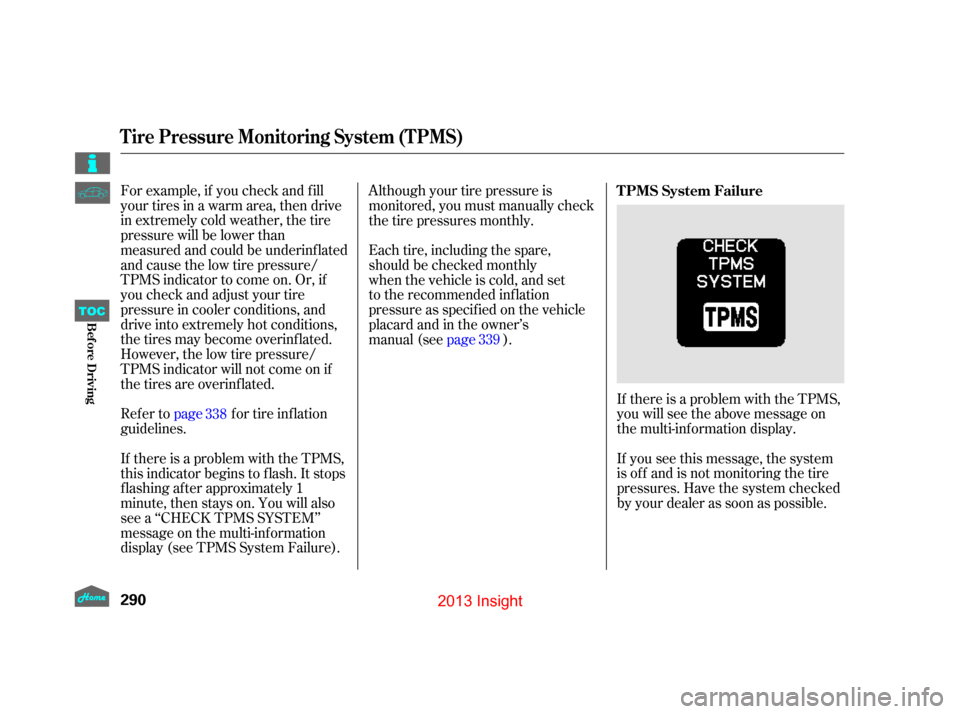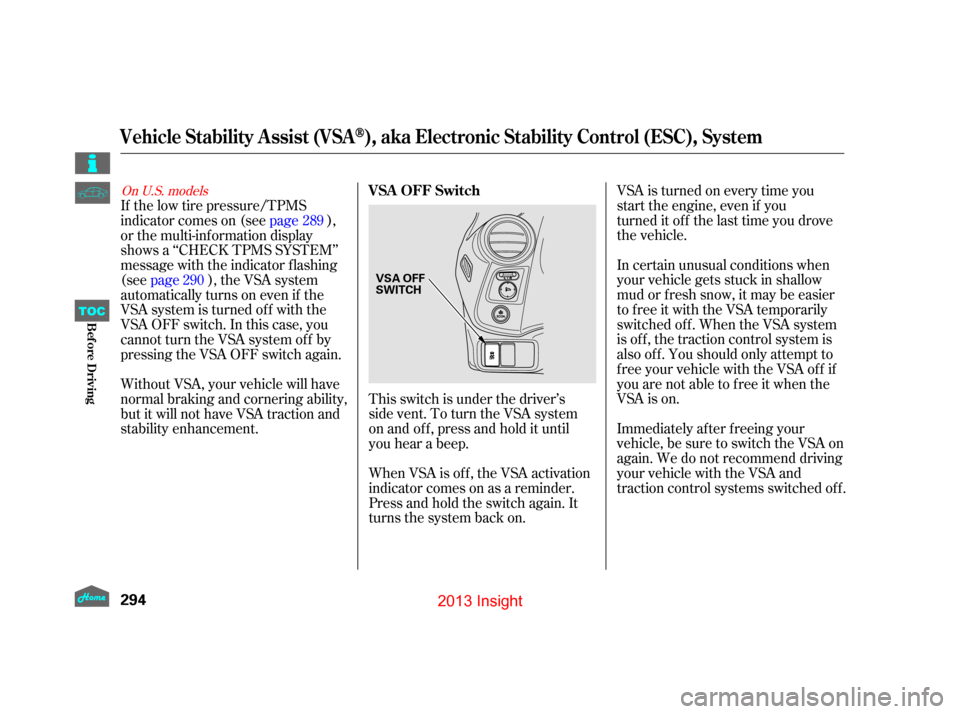HONDA INSIGHT 2013 2.G Owners Manual
Manufacturer: HONDA, Model Year: 2013, Model line: INSIGHT, Model: HONDA INSIGHT 2013 2.GPages: 411, PDF Size: 8.94 MB
Page 291 of 411

If the ABS indicator and the brake
system indicator come on together,
and the parking brake is f ully
released, the EBD system may also
be shut down.
Test your brakes as instructed on
page. If the brakes feel normal,
drive slowly and have your vehicle
repaired by your dealer as soon as
possible. Avoid sudden hard braking
which could cause the rear
wheels to lock up and possibly
lead to a loss of control. Always steer moderately
when you are braking hard. Severe
or sharp steering wheel movement
can still cause your vehicle to veer
into oncoming traffic or off the road.
on loose or
uneven surfaces, such as gravel or
such as trying to take a
corner too f ast or making a sudden
lane change. Always drive at a It only helps with steering
control during braking.
366 Important Saf ety Reminders ABS cannot prevent a loss of
stability.
A vehicle with A BS may require a
longer distance to stop
A BS will not prevent a skid that
results f rom changing direction
abruptly, A BS does not reduce the time or
distance it takes to stop the
vehicle.
Anti-lock Brakes (ABS)
288
12/07/13 17:13:50 31TM8630_293
safe speed for the road and
weather conditions. anti-lock. or snow, than a vehicle without
Bef ore DrivingTOC
2013 Insight
Page 292 of 411

If you think you can safely drive a
short distance to a service station,
proceed slowly to the station, then
inflate the tire to the
recommended pressure.
Driving on a signif icantly under-
inf lated tire causes the tire to
overheat and can lead to tire failure.
Under-inf lation also reduces f uel
efficiency and tire tread life, and may
af f ect the vehicle’s handling and
stopping ability.
Becausetirepressurevariesby
temperature and other conditions,
the low tire pressure/TPMS
indicator may come on unexpectedly. If the tire is flat, or if the tire
pressure is too low to continue
driving, replace the tire with the
compact spare tire (seepage).
When the low tire pressure/TPMS
indicator is on, one or more of your
tires is significantly underinflated.
You should stop and check your
tires as soon as possible, and inflate
them to the proper pressure
as indicated on the vehicle’s tire
information placard.
Your vehicle is equipped with a tire
pressure monitoring system (TPMS)
that turns on every time you start the
engine and monitors the pressure in
your tires while driving.
Each tire has its own pressure
sensor. If the air pressure of a tire
becomes signif icantly low, the
sensor in that tire immediately sends
a signal that causes the low tire
pressure/TPMS indicator in the
instrument panel to come on. If this
happens, you will see a ‘‘CHECK
TIRE PRESSURE’’ message on the
multi-inf ormation display.
If you cannot make the low tire
pressure/TPMS indicator and
message on the multi-information
display go out after inflating the
tires to the specified values, have
your dealer check the
system as soon as possible. 348
CONT INUED
U.S. models onlyLow Tire Pressure/
TPMS Indicator
Tire Pressure Monitoring System (TPMS)
289
12/07/13 17:13:58 31TM8630_294
Bef ore DrivingTOC
2013 Insight
Page 293 of 411

For example, if you check and f ill
your tires in a warm area, then drive
in extremely cold weather, the tire
pressure will be lower than
measured and could be underinf lated
and cause the low tire pressure/
TPMS indicator to come on. Or, if
youcheckandadjustyourtire
pressure in cooler conditions, and
drive into extremely hot conditions,
thetiresmaybecomeoverinflated.
However, the low tire pressure/
TPMS indicator will not come on if
thetiresareoverinflated.
Refer topage for tire inflation
guidelines. Although your tire pressure is
monitored, you must manually check
thetirepressuresmonthly.
Each tire, including the spare,
should be checked monthly
when the vehicle is cold, and set
to the recommended inflation
pressure as specified on the vehicle
placard and in the owner’s
manual (see
page).
If there is a problem with the TPMS,
you will see the above message on
the multi-information display.
If you see this message, the system
is of f and is not monitoring the tire
pressures. Have the system checked
by your dealer as soon as possible.
If there is a problem with the TPMS,
this indicator begins to f lash. It stops
flashing after approximately 1
minute, then stays on. You will also
see a ‘‘CHECK TPMS SYSTEM’’
message on the multi-inf ormation
display (see TPMS System Failure). 338
339TPMS System Failure
Tire Pressure Monitoring System (TPMS)
290
12/07/13 17:14:06 31TM8630_295
Bef ore DrivingTOC
2013 Insight
Page 294 of 411

This indicator and the warning
message on the multi-inf ormation
display will go of f , af ter several miles
(kilometers) driving, when the spare
tire is replaced with the specified
regular tire equipped with the tire
pressure monitor sensor.
Also, the low tire pressure/TPMS
indicator begins to f lash, then stays
on (see
page ).
If the low tire pressure/TPMS
indicator comes on, or the multi-
inf ormation display shows a
‘‘CHECK TPMS SYSTEM’’ message,
the VSA system automatically turns
on even when the VSA system is
turned of f by pressing the VSA OFF
switch (see page). If this
happens, you cannot turn the VSA
system of f by pressing the VSA OFF
switch again.
When you restart the vehicle with
thecompactsparetire,theTPMS
system message will also be
displayed on the multi-inf ormation
display af ter several miles
(kilometers) driving. If you have a f lat tire, the low tire
pressure/TPMS indicator will come
on. Replace the f lat tire with the
compact spare tire (see
page).
After the flat tire is replaced with
the spare tire, the low tire pressure/
TPMS indicator stays on while
driving. After several miles
(kilometers) driving, this indicator
begins to flash, then stays on again.
You will also see a ‘‘CHECK TPMS
SYSTEM’’ message on the multi-
information display. This is normal;
the system cannot monitor the
spare tire pressure. Manually check
the spare tire pressure to be sure it
is correct. Each wheel (except the compact
sparetirewheel)isequippedwitha
tire pressure sensor. You must use
TPMS specif ic wheels. It is
recommended that you always have
your tires serviced by your dealer or
qualif ied technician.
289
294 349
CONT INUED
Changing a T ire with T PMS
Tire Pressure Monitoring System (TPMS)
291
12/07/13 17:14:13 31TM8630_296
Bef ore DrivingTOC
2013 Insight
Page 295 of 411

Never use a puncture-repairing agent
in a f lat tire. If used, you will have to
replace the tire pressure sensor.
Havetheflattirerepairedbyyour
dealer as soon as possible.This device complies with the
appropriate requirements or the
required standards. See
pagef or
more inf ormation. 392
Tire Pressure Monitoring System (TPMS)
292
12/07/13 17:14:17 31TM8630_297
Bef ore DrivingTOC
2013 Insight
Page 296 of 411

If this indicator comes on while
driving, pull to the side of the road
when it is saf e, and turn of f the
engine. Reset the system by
restarting the engine. If the VSA
system indicator stays on or comes
back on while driving, have the VSA
system inspected by your dealer.
If the indicator does not come on
when the ignition switch is turned to
the ON (II) position, there may be a
problem with the VSA system. Have
your dealer inspect your vehicle as
soon as possible. When VSA activates, you will see the
VSA system indicator blink.
The vehicle stability assist (VSA)
system helps to stabilize the vehicle
during cornering if the vehicle turns
more or less than desired. It also
assists you in maintaining traction
while accelerating on loose or
slippery road surf aces. It does this
by regulating the engine’s output and
by selectively applying the brakes.
When VSA activates, you may notice
that the engine does not respond to
the accelerator in the same way it
does at other times. There may also
be some noise f rom the VSA
hydraulic system. You will also see
the VSA activation indicator blink.
The VSA system cannot enhance the
vehicle’s driving stability in all
situations and does not control your
vehicle’s entire braking system. It is
still your responsibility to drive and
corner at reasonable speeds and to
leave a sufficient margin of safety. When VSA is off, the VSA OFF
indicator comes on as a reminder.
The VSA system indicator will also
come on when there is a problem in
the hill start assist system. For more
inf ormation, see
page.
The main f unction of the
VSA system is generally known as
Electronic Stability Control (ESC).
The system also includes a traction
control f unction.
When the VSA system indicator
comes on, you will also see a
‘‘CHECK VSA SYSTEM’’ or
‘‘CHECK HILL START ASSIST
SYSTEM’’ message on the multi-
inf ormation display. 295
Vehicle Stability Assist
(VSA ) System Indicator VSA OFF Indicator
Vehicle Stability A ssist (VSA), aka Electronic Stability Control (ESC), System
293
NOTE:
12/07/13 17:14:27 31TM8630_298
Bef ore DrivingTOC
2013 Insight
Page 297 of 411

Immediately af ter f reeing your
vehicle, be sure to switch the VSA on
again. We do not recommend driving
your vehicle with the VSA and
traction control systems switched off. In certain unusual conditions when
your vehicle gets stuck in shallow
mud or f resh snow, it may be easier
to free it with the VSA temporarily
switched of f . When the VSA system
is of f , the traction control system is
alsooff.Youshouldonlyattemptto
f ree your vehicle with the VSA of f if
you are not able to f ree it when the
VSA is on. VSA is turned on every time you
start the engine, even if you
turned it off the last time you drove
the vehicle.
When VSA is off, the VSA activation
indicator comes on as a reminder.
Press and hold the switch again. It
turns the system back on. This switch is under the driver’s
side vent. To turn the VSA system
on and off, press and hold it until
you hear a beep.
If the low tire pressure/TPMS
indicator comes on (seepage),
or the multi-information display
shows a ‘‘CHECK TPMS SYSTEM’’
message with the indicator flashing
(see
page ), the VSA system
automatically turns on even if the
VSA system is turned off with the
VSA OFF switch. In this case, you
cannot turn the VSA system of f by
pressing the VSA OFF switch again.
Without VSA, your vehicle will have
normal braking and cornering ability,
but it will not have VSA traction and
stability enhancement. 289
290
On U.S. models
Vehicle Stability A ssist (VSA), aka Electronic Stability Control (ESC), System
VSA OFF Switch
294
VSA OFF
SWITCH
12/07/13 17:14:34 31TM8630_299
Bef ore DrivingTOC
2013 Insight
Page 298 of 411

Driving with varying tire or wheel
sizes may cause the VSA to
malf unction. When replacing tires,
make sure they are of the same size
and type as your original tires (see
page).
If you install winter tires, make sure
they are the same size as those that
were originally supplied with your
vehicle. Exercise the same caution
during winter driving as you
would if your vehicle was not
equipped with VSA. Your vehicle is equipped with a hill
start assist f eature to help prevent
the vehicle f rom rolling on inclines
as you move your f oot f rom the
brake pedal to the accelerator.
To activate hill start assist, you must
come to a complete stop and make
sure the shift lever is in any of D, S
or L (either in D or S on models with
the paddle shifters) when facing
uphill, or reverse when facing
downhill. Release the brake pedal.
The brakes remain engaged briefly
to keep the vehicle from rolling
forward or backward while
you move your foot from the brake
pedal to the accelerator pedal.
Gently apply the accelerator
pedal as in normal driving. Hill start
assist will release brake pressure
gradually as you accelerate.Hillstartassistmaynotpreventyour
vehicle f rom rolling downhill on a
very steep or slippery slope, and will
not operate on small inclines.
Hill start assist is not a replacement
for the parking brake. If parking
your vehicle, ensure that the
transmission is in Park, and the
parking brake is fully applied before
exiting the vehicle. You should also
turn off the engine before
exiting the vehicle.
The VSA system indicator will come
on when there is a problem in the hill
start assist system. With the VSA
system indicator on, the hill start
assist system will not activate.
Hill start assist will still operate even
when VSA is switched off.
342
Vehicle Stability A ssist (VSA), aka Electronic Stability Control (ESC), System
VSA and Tire Sizes
Hill Start Assist System
295
12/07/13 17:14:42 31TM8630_300
Bef ore DrivingTOC
2013 Insight
Page 299 of 411

Your vehicle is not designed to tow a
trailer. Attempting to do so can void
your warranties.
Towing a Trailer
296
12/07/13 17:14:45 31TM8630_301
Bef ore DrivingTOC
2013 Insight
Page 300 of 411

This section explains why it is
important to keep your vehicle well
maintained and how to f ollow basic
maintenance saf ety precautions.
If you have the skills and tools to
perf orm more complex maintenance
tasks on your vehicle, you may want
to purchase the service manual. See
pagef or inf ormation on how to
obtain a copy, or see your dealer.
U.S. Vehicles:
This section also includes
instructions on how to read the
Maintenance Minder messages on
the multi-information display, and
instructions for simple
maintenance tasks you may want
to take care of yourself.
......................Maintenance Saf ety.298
.................Maintenance Minder .299
..............................Fluid Locations.309
........................Adding Engine Oil.310
.........Changing the Oil and Filter .312
..............................Engine Coolant.315
....................Windshield Washers. 317
....Automatic Transmission Fluid .318
Continuously Variable
............Transmission (CVT) .318
....................................Brake Fluid.319
.............................................Lights.321
..............................Audio Antenna.331
................Cleaning the Seat Belts .331
.....................................Floor Mats.331
..................DustandPollenFilter .332
.................................Wiper Blades.332
...............................................Tires.338
......Checking the 12 Volt Battery. 344
.............................Vehicle Storage.346
397
Maintenance
Maintenance, replacement, or
repair of emissions control
devices and systems may be done
by any automotive repair
establishment or individual using
parts that are ‘‘certif ied’’ to EPA
standards.
Maint enance
297
TM
12/07/13 17:14:50 31TM8630_302
2013 Insight